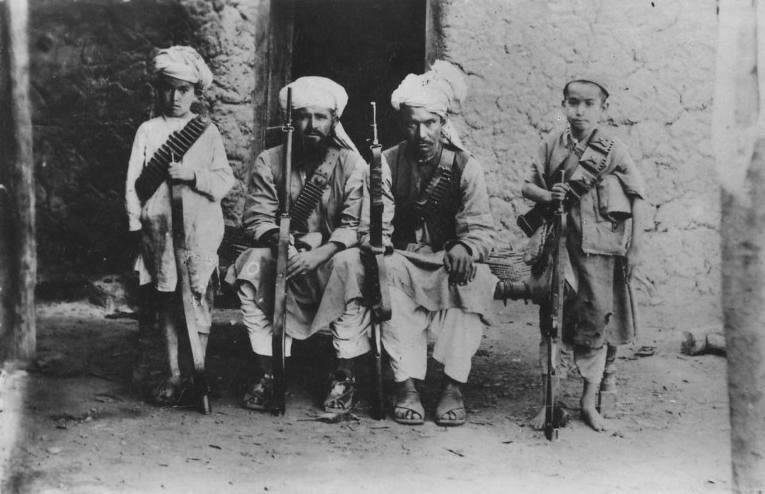
The British Raj: Northwest Frontier

Figure 1.--The fabeled Kyber Pass is the best known of the passes through the ruggest Northwest Frontier area. This is part of the Afridi fmily helping the British to guard the Kohat Pass. The boys are pesumabnly sons of the two tribesmen. A descendent, Shahid Afridi, is today a major cricket star. A reader writes, "Did you notice that the kids' rifles are shorter then the adults." We think that means that the boys were not just posing for the camera, but had arms that they were able to use and were actually part of the tribal fighting force. Source: No 38KC Meehra, Peshawar.
|
|
The passes in the northwestern area of the Subcontinent were the traditional route from invader from the Steppe and Near-East. Further east the towering Himilayas blocked invasions. This was presumably the route of the Aryans who conquered the Indus Valley civilization, This was Alexander's route in his efforts to conquer India. It was also the route of the Mongols and allied Neareasern Tribe that helped establish the Mogul Empire. The British, however, came from the south by sea. Once the British founded the Raj, they set out to defend it and this meant controlling the North-West Frontier region, which include areas of modern southwest Afghanistan and northwestern Pakistan. It thus proved strategically the most important and as a result the most difficult area of the Raj to control.
The modern frontier in what was the Northwest Frontier is based on the Durand Line and divides the Pashtun (Pathan) inhabitants of southern Afghanistan frm their ethnic kinsmen in Pakistan. The two principal gateways through the rugged Northwest Frontier area are the fabeled Khyber and Bolan Passes. As the Russian Empire moved into central Asia (mid-19th century), this set up a conflict between the expanding Russian Empire and the British defending the Raj (late-19th century). It became known as the Great Game. The Crimean War and the Great Game created a great deal of animosity between the Russians on one side and the English and French on on the otherside. Chancellor Bismarck exploited this diplomatic clevage and after the foundatiion of the German Empire negotiated a series of alliance with the Russians (1872-87). It was an alliance based on mutual interests. The German-Russian frontier was stable wih no territorial claims and the two had strong monarchial systems with family ties to preserve. Kaiser Wilhelm II in a move of stunning incompetence after dismissing Bismarck allowed the treaty with Russia to lapse (1890). The Great Game, however, continued and fed into the instability of the Northwest Frontier. For the British stability of the Frontier and efforts to control Afghanistan became central to the defense of the Raj. And the Russians did what they could to stir up resistance to the British in Afghanistan. Ranjit Singh conquered much of the Northwest Frontier area (early-19th century). The British subseuently in the wake of the Indian Mutiny annexed the Punjab (1849). The Punjab is just south of the Frontier Area and the British from the Punjab moved into it for the first time. The result was a succession of punitive British military expeditions against raiding Pashtun tribesmen and three actual wars with Afghans. Many of the notable British officers who who fought in World War I and II got much of their early military experience as young officers on the NorthWest Frontier which the British called the Grim.
CIH

Navigate the Children in History Website:
[About Us]
[Introduction]
[Animals]
[Biographies]
[Chronology]
[Climatology]
[Clothing]
[Disease and Health]
[Economics]
[Ethnicity]
[Geography]
[History]
[Human Nature]
[Law]
[Nationalism]
[Presidents]
[Religion]
[Royalty]
[Science]
[Social Class]
[Bibliographies]
[Contributions]
[FAQs]
[Glossaries]
[Images]
[Links]
[Registration]
[Tools]
[Children in History Home]
Navigate the Boys' Historical Clothing national pages:
[Return to the Maon Afghan Great Game page]
[Return to the Main British Raj page]
[Return to the Main Indian history British period]
[Return to the Main Indian history page]
[Return to the Main Pakistani history page]
[Return to the Main countries page]
[Australia]
[Banladesh]
[Burma]
[China]
[India]
[Indonesia]
[Japan]
[Korea]
[Malaysia]
[Nepal]
[Pakistan]
[Sri Lanka]
[England]
Created: 7:54 PM 4/21/2013
Last updated: 1:30 AM 4/22/2013



